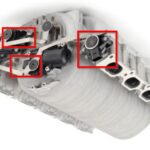Experiencing the frustration of a persistent check engine light after repairs? You’re not alone. Many DIY mechanics and car owners encounter this issue, especially when dealing with emissions-related problems. Let’s delve into a common culprit: the P1440 code, often indicating an issue within your vehicle’s Evaporative Emission Control (EVAP) system. This article will explore the P1440 code, its potential causes, and troubleshooting steps, drawing insights from a real-world repair scenario.
The P1440 code generally points to an “Evaporative Emission Control System Purge Flow Fault.” This means your car’s computer, or Powertrain Control Module (PCM), has detected an issue with the purge flow within the EVAP system. The EVAP system is designed to prevent fuel vapors from escaping into the atmosphere. It captures these vapors and, at the right time, purges them into the engine to be burned. A P1440 code suggests that this purge flow isn’t happening as expected.
One DIYer documented their experience tackling a persistent check engine light, highlighting common steps and frustrations. They began by addressing potential blockages in the EVAP system lines, even before replacing any parts. This proactive approach is commendable, as simple clogs can often trigger EVAP system codes. The user reported: “I went ahead and blew out the small tubes in the engine bay because I didn’t have the parts to do the complete fix yet but I wanted to do whatever I could.” This is a good initial step to ensure clear pathways for vapor flow.
They also suspected the gas cap, a frequent cause of EVAP system leaks. “At this time I also took my gas cap off and put it back on just in case that was contributing to the problem.” A loose or faulty gas cap can indeed lead to EVAP system leaks and trigger codes, making it a simple first check.
Interestingly, the check engine light temporarily went off after refueling. “On Thursday I filled up my tank and a minute later the light was gone.” This could suggest pressure changes within the fuel tank temporarily cleared a blockage or sealed a minor leak. However, as the user experienced, this fix was short-lived.
The DIYer then proceeded to replace the charcoal canister and canister purge valve, common components in the EVAP system known to fail. “The code stayed off until this weekend when I replaced the canister and canister valve… I then replaced the canister and valve and put everything back together.” Replacing these parts is a logical step when troubleshooting EVAP codes, especially if they are suspected to be faulty due to age or wear.
Despite these replacements, the check engine light returned, this time potentially with a related code, P1444 (though it’s crucial to confirm the exact code with a scanner). “I drove about half a mile and the check engine light came back on. This time it is a p1444 i believe (something to do with the canister purge valve).” This highlights the complexity of diagnosing EVAP system issues. Even after replacing suspected components, the underlying problem might persist.
Possible reasons for a recurring P1440 or related codes after parts replacement include:
- Vacuum Leaks: Leaks in any of the EVAP system hoses or connections can disrupt the purge flow. Thoroughly inspect all hoses for cracks, damage, or loose connections.
- Faulty Purge Valve: Even a new purge valve can be defective. Testing the valve’s functionality is crucial.
- Wiring or Connector Issues: Problems with the wiring or electrical connector to the purge valve can prevent it from operating correctly. Inspect the connector for corrosion or damage and check the wiring for continuity.
- PCM Issue (Less Likely): In rare cases, the PCM itself might be misinterpreting sensor readings or have an internal fault. This is usually diagnosed after ruling out other possibilities.
Troubleshooting a P1440 code effectively requires a systematic approach. Start with the simple checks like the gas cap and hose inspections. Utilize a scan tool to confirm the exact code and consider using a smoke machine to pinpoint any vacuum leaks in the EVAP system. Testing the purge valve’s operation with a multimeter and verifying wiring continuity are also essential steps.
In conclusion, the P1440 code indicates an EVAP system purge flow fault, often stemming from vacuum leaks, a malfunctioning purge valve, or wiring issues. While replacing components like the canister and purge valve is a common repair strategy, a thorough diagnostic process is crucial to pinpoint the root cause and ensure a lasting fix. Don’t get discouraged by a persistent check engine light – systematic troubleshooting will lead you to the solution.
